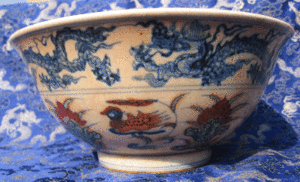Forensic scienceForensic science to foiling fakers of Chinese art
The field of Chinese art has become one of the hottest sectors of the global art market in recent years, and nowhere more so than in the demand for fine antique porcelain; prices for the finest Imperial porcelain have soared, but so have the ambitions of accomplished fakers, seeking to infiltrate exquisite new fakes into a market eager for top quality material; a joint effort by university researchers and an auction house will see the application of forensic science in the authentication of Chinese artifacts

Chinese porcelain, a favored target of counterfeiters // Source: asianart.com
Cranfield University and venerable auction house Bonhams have inaugurated a joint forensic science research project to bring authentication techniques into the world of art.
The new Cranfield/Bonhams collaboration combines advances in the ability to identify ever-smaller proportions of trace elements, with essentially non-invasive sampling, associated with identifying a coherent range of authentic objects to provide the core data. A Cranfield University release reports that this will be particularly useful in the field of Chinese art which has become one of the hottest sectors of the global art market in recent years, and nowhere more so than in the demand for fine antique porcelain. Prices for the finest Imperial porcelain have soared, but so have the ambitions of accomplished fakers, seeking to infiltrate exquisite new fakes into a market eager for top quality material. Technology exists to distinguish scientifically the genuine treasures from the fakes, but the technology normally used is over forty years old, invasive, and no longer entirely trustworthy.
Forensic science often manages to identify small differences in very rare elements in an object. These “trace elements” can often identify an object’s place, and sometimes date, of origin if a good database already exists for similar objects. Trace element analysis is regularly used in many kinds of detective work, from establishing the original source of premium organic foods to researching crime scene evidence.
The release notes that it has never been practical in the past to use it systematically in the art market, because obtaining samples has often been unacceptably destructive, and databases are neither detailed nor specific enough. The Cranfield/Bonhams project aims to change that.
“This is the most exciting art-authentication project I have ever seen,” commented Colin Sheaf, chairman of Bonham’s Asia and the global auctioneer’s senior Chinese art specialist.
For decades we have sought a forensic technology which will easily and reliably address the authenticity problems generated by 30 years of relentless faking of expensive Chinese ceramics.
Cranfield’s team will now provide the specialist technology and experienced forensic scientists to carry out the analysis, and Bonham’s will define the practical issues and provide access to the core data material. We will work together to establish the methodology that will give us all confidence to make robust deductions from tiny quantities of core sample.
This project combines cutting-edge Western technology with China’s finest Imperial art in a unique and unprecedented collaboration. It will be of immense benefit to both participants, and to the wider academic and commercial art market. It will add greatly to the current expertise that we already bring to bear on analysis of an object to establish its provenance.”
Dr. Andrew Shortland, reader in Forensic Archaeomaterials and director of the Center for Archaeological and Forensic Analysis at Cranfield University said, “Cranfield has made significant investments in new laboratories and staff to extend our forensic analytical abilities. The analysis of a wide range of art and historical objects is one of the most exciting growth areas for us. It is a pleasure to work with the experts from Bonhams on this project, and I look forward to developing robust scientific techniques to help them in their identification of copies and fakes.”
